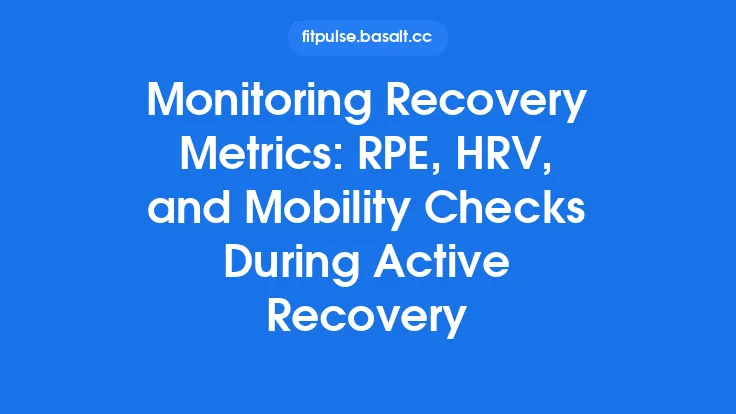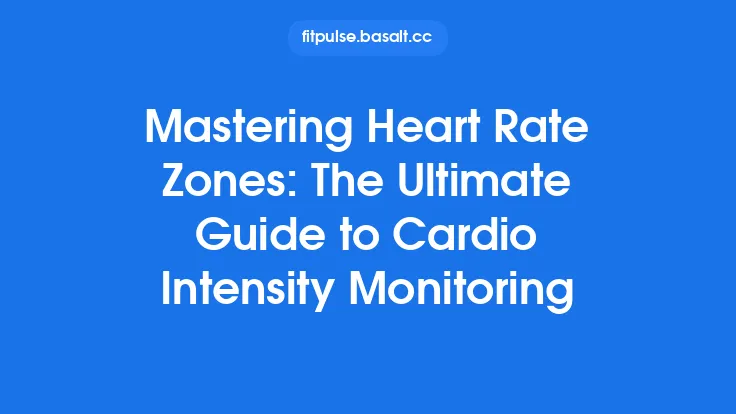Recovery after injury is a dynamic process that unfolds across multiple physiological systems, and the decision to allow an athlete back into competition should be anchored in data rather than intuition alone. By systematically tracking a suite of recovery metrics, clinicians, coaches, and performance staff can spot subtle signs of lingering deficits, gauge the effectiveness of rehabilitation interventions, and make evidence‑based return‑to‑play (RTP) decisions. This article outlines the most reliable metrics, the technologies that capture them, and a practical framework for turning raw numbers into actionable insights.
Why Objective Monitoring Matters
- Reduces Guesswork – Subjective impressions of “feeling better” can be misleading, especially when athletes under‑report pain or over‑estimate readiness to protect their position on the team. Objective data provide a common language for all stakeholders.
- Identifies Hidden Deficits – Injuries often produce compensatory patterns that persist long after pain subsides. Metrics such as asymmetrical force production or altered heart‑rate variability (HRV) can reveal these hidden issues before they manifest as re‑injury.
- Tracks Rehabilitation Effectiveness – Quantifying progress allows clinicians to adjust loading, modify exercises, and validate that prescribed interventions are delivering the intended physiological adaptations.
- Supports Evidence‑Based RTP Criteria – While many RTP guidelines list “meeting functional benchmarks,” the underlying data that define those benchmarks must be collected, stored, and interpreted consistently.
Core Physiological Metrics
| Metric | What It Reflects | Typical Monitoring Frequency | Key Interpretation Tips |
|---|---|---|---|
| Resting Heart Rate (RHR) | Autonomic balance, overall cardiovascular stress | Daily (morning) | Persistent elevation (>5 bpm above baseline) may signal residual systemic stress or infection. |
| Heart‑Rate Variability (HRV) | Parasympathetic tone, recovery capacity | Daily (morning) | Declines >10 % from baseline for >3 consecutive days suggest inadequate recovery. |
| Sleep Quantity & Quality (total hours, sleep efficiency, REM %) | Hormonal regulation, tissue repair | Nightly (wearable or bedside monitor) | <6 h or sleep efficiency <85 % for >5 nights correlates with impaired performance and higher injury risk. |
| Inflammatory Biomarkers (CRP, IL‑6, CK) | Tissue damage, systemic inflammation | 2–3× per week (blood draw) | Elevated CRP (>5 mg/L) or CK (>300 U/L) beyond expected post‑exercise peaks may indicate ongoing inflammation. |
| Hormonal Ratios (Testosterone:Cortisol) | Catabolic vs. anabolic state | Weekly (saliva or blood) | A ratio <0.5 can flag chronic stress and impaired tissue remodeling. |
Practical tip: Establish each athlete’s baseline during a fully healthy training block (minimum 2 weeks) and use that as the reference point for all subsequent comparisons.
Biomechanical and Functional Metrics
| Metric | Capture Method | Relevance to RTP |
|---|---|---|
| Force‑Plate Asymmetry (peak force, impulse) | Dual‑plate force platform during squat or jump | Detects unilateral deficits that may predispose to re‑injury. |
| Ground‑Reaction Force (GRF) Loading Rate | Force plates or instrumented treadmill | High loading rates (>50 BW/s) can stress healing tissues, especially tendons. |
| Joint Kinematics (hip/knee/ankle angles) | 3‑D motion capture or inertial measurement units (IMUs) | Aberrant movement patterns (e.g., reduced knee flexion) highlight compensations. |
| Muscle Activation Timing (EMG onset/offset) | Surface EMG sensors | Delayed activation of stabilizing muscles (e.g., gluteus medius) signals neuromuscular control issues. |
| Isokinetic Strength Ratios (concentric/eccentric) | Isokinetic dynamometer | Imbalances >10 % between limbs or between concentric/eccentric phases suggest incomplete recovery. |
Interpretation nuance: Small asymmetries are normal; the focus should be on trends. A sudden increase in asymmetry after a load increase is a red flag, even if absolute values remain within “acceptable” ranges.
Load‑Related and Fatigue Indicators
- External Load Metrics – GPS‑derived distance, acceleration/deceleration counts, and player‑load scores. Sudden spikes (>20 % week‑to‑week) are associated with higher injury incidence.
- Internal Load Metrics – Session Rating of Perceived Exertion (sRPE) multiplied by duration, and blood lactate responses. Discrepancies between external and internal load (high external load but low perceived exertion) may indicate under‑reporting or masking of fatigue.
- Neuromuscular Fatigue – Countermovement jump (CMJ) height and flight‑time‑to‑contact ratio. A drop of >5 % from baseline across two consecutive sessions suggests insufficient recovery.
- Autonomic Fatigue – HRV trends combined with resting HR. A simultaneous rise in RHR and drop in HRV is a strong fatigue signal.
Decision rule of thumb: If any two fatigue indicators cross pre‑defined thresholds within a 48‑hour window, consider postponing the next high‑intensity session or adjusting the RTP progression.
Subjective and Contextual Metrics (Beyond Pure Psychology)
While psychological readiness is covered elsewhere, athletes’ self‑reported sensations still provide valuable context:
- Pain Scores – Numeric Rating Scale (0–10) recorded each morning and post‑session. Persistent pain >3 at rest warrants re‑evaluation.
- Perceived Recovery Status (PRS) – 0 (very poorly recovered) to 10 (fully recovered). Consistently low PRS (<5) despite objective improvements may indicate hidden stressors.
- Wellness Questionnaires – Sleep, mood, nutrition, and soreness items compiled into a single wellness index. Declines in the composite score often precede performance drops.
These data points should be logged in the same platform as physiological metrics to enable correlation analyses.
Data Collection Tools and Best Practices
| Tool Category | Examples | Strengths | Limitations |
|---|---|---|---|
| Wearables | Chest‑strap HR monitors, wrist HRV sensors, smart rings | Continuous, low‑burden, real‑time feedback | Variable accuracy for HRV; need validation against gold‑standard ECG. |
| GPS & LPS | Catapult, STATSports, Polar LPS | Precise external load quantification | Signal loss indoors; requires calibration. |
| Force Platforms | AMTI, Kistler, portable force plates | Gold‑standard for force asymmetry | Expensive, limited to lab or dedicated training area. |
| IMUs | Xsens, Notch, MyoMotion | Portable kinematic capture | Requires robust algorithms to translate raw data into meaningful metrics. |
| Biochemical Assays | Point‑of‑care CRP kits, dried‑blood spot cortisol | Objective inflammation/hormone status | Invasive; timing relative to training must be standardized. |
| Cloud‑Based Data Management | AthleteMonitoring.com, Kitman Labs | Centralized dashboard, multi‑user access | Data security and privacy compliance (GDPR, HIPAA) must be ensured. |
Best‑practice checklist
- Standardize measurement timing (e.g., HRV first thing in the morning, blood draws at least 2 h post‑exercise).
- Calibrate devices regularly and document any firmware updates.
- Train all staff on proper sensor placement and data entry to minimize inter‑rater variability.
- Implement data validation rules (e.g., flag outliers >3 SD from the mean for review).
- Secure informed consent and maintain a clear data‑retention policy.
Interpreting Trends and Setting Thresholds
- Baseline Establishment – Collect at least 14 days of data during a fully healthy period. Compute mean, standard deviation, and coefficient of variation for each metric.
- Individualized Thresholds – Rather than using generic cut‑offs, define “alert zones” as ±1.5 × SD from baseline for each athlete. This respects inter‑individual variability.
- Multi‑Metric Fusion – Use a weighted scoring system (e.g., 30 % HRV, 25 % force asymmetry, 20 % sleep efficiency, 15 % pain, 10 % load spikes). A composite score >70 % of the maximum indicates readiness; <50 % suggests delay.
- Temporal Smoothing – Apply a rolling 3‑day average to reduce day‑to‑day noise, especially for HRV and sleep metrics.
- Contextual Overlay – Align metric trends with training cycles (e.g., taper, competition) and external stressors (travel, academic exams) to avoid misinterpretation.
Integrating Metrics into the RTP Decision Process
- Pre‑Rehabilitation Review – Document baseline metrics, injury specifics, and target RTP timeline.
- Weekly Multidisciplinary Meeting – Clinician, strength & conditioning coach, sport scientist, and, when appropriate, the athlete review the latest dashboard.
- Decision Matrix – For each metric, assign a status: Green (within baseline), Yellow (approaching threshold), Red (exceeds threshold). RTP progression is permitted only when all metrics are Green or a maximum of one Yellow with a clear remediation plan.
- Documentation – Record the rationale for each RTP decision, linking it to specific metric values. This creates an audit trail and facilitates future research.
- Feedback Loop – After each RTP milestone (e.g., return to full training, first competition), reassess metrics to confirm that the athlete maintains the “green” status under increased sport demands.
Multidisciplinary Communication and Documentation
- Shared Dashboard – A cloud‑based platform where all stakeholders can view real‑time metrics, annotate observations, and flag concerns.
- Standardized Reporting Template – Include sections for physiological data, biomechanical data, load metrics, subjective wellness, and the final RTP recommendation.
- Alert System – Automated email or app notifications when any metric crosses its individualized threshold, prompting immediate review.
- Confidentiality Protocols – Role‑based access ensures that only authorized personnel view sensitive health data, complying with legal and ethical standards.
Emerging Technologies and Future Directions
- Machine Learning Predictive Models – Training algorithms on large datasets to predict re‑injury risk based on subtle metric interactions (e.g., combined HRV‑load‑asymmetry patterns).
- Continuous Metabolite Monitoring – Wearable sweat sensors that track lactate, glucose, and cortisol in real time, offering a metabolic view of recovery.
- Smart Orthotics – Embedded force sensors in shoes or braces that provide ongoing asymmetry data during everyday activities, not just lab sessions.
- Virtual Reality (VR) Assessment – Immersive environments that challenge neuromuscular control while simultaneously capturing kinematic and physiological data.
- Integrative Health Platforms – Systems that combine medical records, performance data, and nutrition logs, enabling a holistic view of the athlete’s recovery ecosystem.
Adopting these innovations will shift RTP decisions from reactive to proactive, allowing teams to anticipate setbacks before they manifest.
Practical Implementation Checklist
- [ ] Baseline Collection – Minimum 2 weeks of fully healthy data for all core metrics.
- [ ] Device Calibration – Verify accuracy of wearables, force plates, and GPS units.
- [ ] Threshold Definition – Set individualized alert zones (±1.5 SD) for each metric.
- [ ] Dashboard Setup – Configure shared platform with real‑time visualizations and alerts.
- [ ] Weekly Review Protocol – Schedule multidisciplinary meetings with a standard agenda.
- [ ] Decision Matrix Integration – Apply the green/yellow/red status system to each metric.
- [ ] Documentation Workflow – Use the standardized RTP report template for every decision.
- [ ] Data Security Review – Ensure compliance with GDPR/HIPAA and obtain athlete consent.
- [ ] Continuous Education – Train staff on emerging tools and interpretation updates.
By systematically monitoring these recovery metrics, teams can make RTP decisions that are transparent, data‑driven, and tailored to each athlete’s unique physiological profile—ultimately reducing re‑injury risk and optimizing performance longevity.




